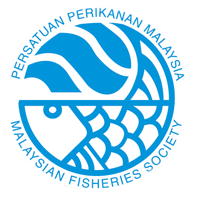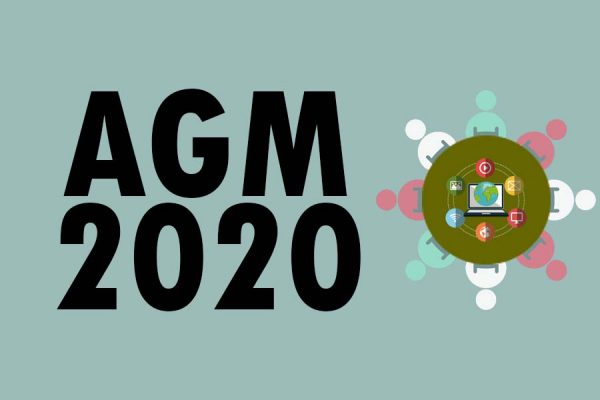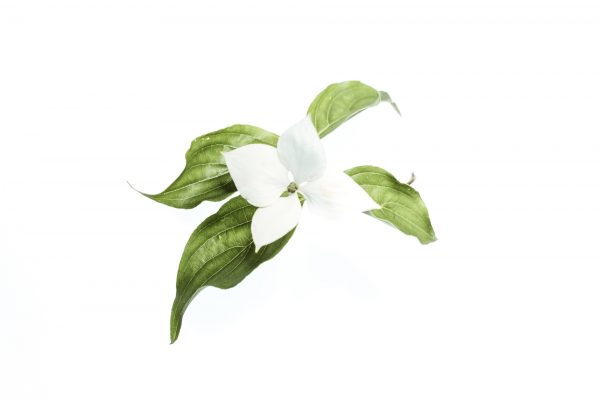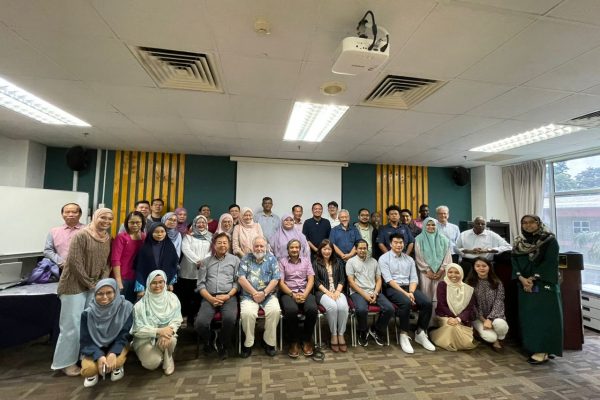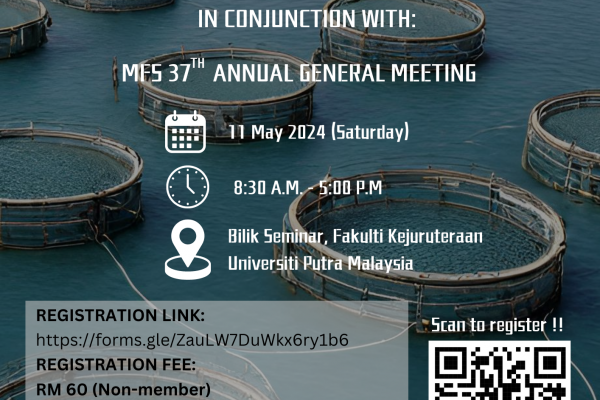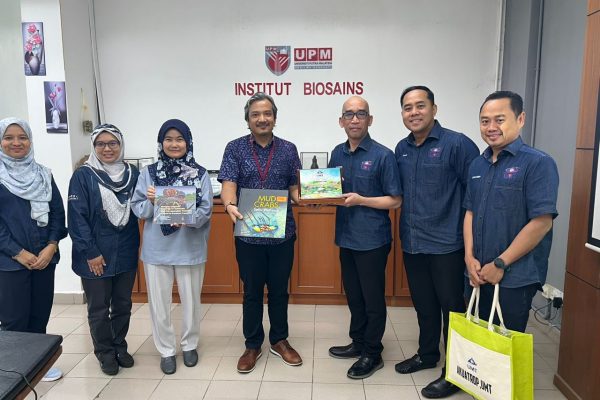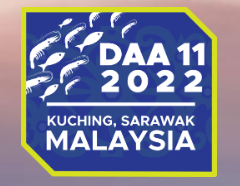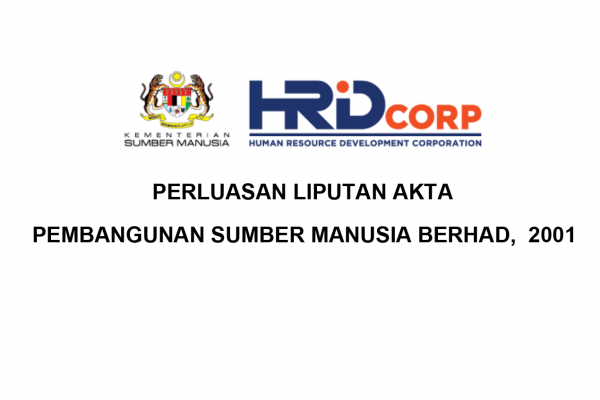
The Malaysian Fisheries Society logo represents a fish which is symbolic for the capture fisheries and aquaculture. The actively swimming fish symbolises a dynamic society. The waves above the fish represent the aquatic environment which includes the freshwater bodies and the marine environment. The blue colour used for the logo represents the aquatic environment. The round shape signifies a holistic and integrated approach to fisheries managament, development and research.

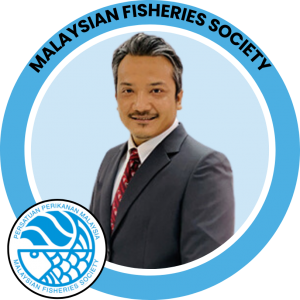
President’s Message
Dear MFS Members and Friends,
First and foremost, I would like to thank all of the MFS members who gave me the opportunity and responsibility to lead this prestigious society. I will try my best to work with all of the council and members, aiming to the MFS motto, to champion the aquaculture and fisheries industry towards a healthy, balanced, and sustainable development.
I would like to take this opportunity to welcome all the new Council Members for the year 2023-2025; Dr. Shahreza Md. Sheriff (Vice-President), Dr. Norulhuda Mohamed Ramli (Honorary Secretary), Dr. Pearl Kwan Penz Penz (Honorary Treasurer), Dr. Nurliyana Mohamad (Council Member), Dr. Azila Abdullah (Council Member), Dr. Norhariani Mohd Nor (Council member), Mr. Henry Wong Yip Hing (Council Member), Prof. Dato’ Dr. Aileen Tan Shau Hwai (Co-opt Member), Assoc. Prof. Dr. Natrah Ikhsan (Co-opt Member), Dr. Nur Diyana Mohamad Tahir (Co-opt Member), Mr. Lee Low (Auditor), and Dr. Abdul Basir V. Kunhimohamed (Auditor).
My heartiest thanks to all the past council members (2020-2023) who had served MFS unconditionally for the past term; Dr. Chong Chou Min (Honorary Secretary), Dr. Zuridah Merican (Council Member), Laura Khor Li Imm (Council Member), Dr. Nur Fatihah Abd. Halid (Council Member), Dr. Loh Jiun Yan (Council Member), Dr. Hadzley Harith (Council Member), Dr. Annie Christianus (Auditor), and Dr. Low Chen Fei (Auditor).
The objectives of the MFS are to advance knowledge on all aspects of fisheries and related activities with particular reference to Malaysia and the neighbouring region so as to foster rational development and management of aquaculture, capture fisheries, and related activities for food, recreation, and conservation. The society does this through the organization of meetings, seminars, and forums and through its various publications.
The new council aims to strengthen the partnership between academia with stakeholders and government agencies to address food security for the nation and create opportunities for all in the area of Fisheries and Aquaculture. We do hope to attract more industrial partners to play a more significant role in moving the agendas of MFS together.
Last but not least, I wish all of you to join and contribute to the MFS. Perhaps, we can work together for the better aquaculture and fisheries development of our beloved country.
Assoc. Prof. Dr. Mohammad Noor Amal Azmai
President
Malaysian Fisheries Society
2023-2025
FISHMAIL at a glance
CONTENTS
- Revolutionising monitoring of alien invasive species (page 2-5).
- The way forward for ornamental fisheries in Malaysia (page 6-12).
- Fish monitoring and assessment based on fish composition and condition: a study of Sungai Tengi sampling reach, Kampung Ampangan, Tanjung Karang, Selangor (page 13-17).
- Mathematical model of microalgae growth with influenced parameter effect (page 18-22).
- Research of Tor tambroides for a sustainable aquaculture in Malaysia (page 23-31).
- Potential usage of SirehmaxTM , a Piper betle extract, for controlling fish pathogen prevalence in domesticated shark catfish fingerlings, Pangasius nasutus (Bleeker, 1863) (page 32-39).
CONTENTS
- Research on Mahseer (Tor sp.) breeding at the Fisheries Research Institute, Glami Lemi, Negeri Sembilan (page 2-5).
- Application of multi-omics and bioinformatics for detection of antimicrobial resistance in aquaculture (page 6-14).
- Biological control for leech infestation in aquaculture (page 5-17).
- Ocean tipping point concept in sustainable fisheries management (page 18-20).
- Life cycle inventory for the giant freshwater prawn, Macrobrachium rosenbergii De Man 1879 culture: a sustainable approach for aquaculture waste management (page 21-29).
- A breeding program to boost the production of giant freshwater prawn (Macrobrachium rosenbergii) in Malaysia (page 30-34).
CONTENTS
- Delivering vaccines via microalgae: The future of disease management in aquaculture industry? (page 2-8).
- Updates on the recent algal bloom and fish kill incidence in fish farming areas in Perak and Penang, Malaysia (page 9-12).
- Enhanced palm lipids for animal nutrition (page 13-16).
- First in commercial milkfish farming in Malaysia (page 17-19).
- Kenyir Lake fisheries resources: Will it last? (page 20-26).
- Assessing the health of Subang Lake, Selangor by using fish assemblages and diversity indices: A preliminary study (page 27-32).
- Special session on Antimicrobial Resistance in Aquaculture at the International Fisheries Symposium 2019 (page 33-34).
CONTENTS
- COVID 19: Impacts on the Malaysian aquaculture industry (page 2-3).
- Perspective: Aquaculture needs clean water, but it can also pollute the waters (page 4-10).
- Lessons from down under: tackling Malaysia’s alien invasive fish management (page 11-16).
- Bioindicators of stress in farmed European seabass, Dicentrarchus labrax (page 17-22).
- Acute effects of an anionic surfactant, linear alkylbenzene sulphonate (LABS) on Daphnia manga (page 23-30).
- Present status and prospects of seaweed production in Bangladesh (page 31-35).
- MFS student awards at the 9th International Fisheries Symposium 2019 (page 36-38).
CONTENTS
- Proximate composition comparison of Nile tilapia Oreochromis niloticus from net cages and earthen pond culture (page 2-4).
- Socio-economics of floating net-cage marine fish farms in Peninsular Malaysia (page 5-9).
- Potential of triploidization for masculinization in red hybrid tilapia (page 10-12).
- Otolith – a powerful tool to understand fish populations (page 13-14).
- Building a case for the conservation of Malaysian horseshoe crabs (page 15-18).
- Should we eat farmed fish? The rise of antimicrobial resistance in aquaculture (page 19-24).
- Prevalence of Vibrio spp. in tropical marine cage-cultured fishes (page 25-27).
- Seminar and Dialogue on R&D for Sustainable Aquaculture and Fisheries, in conjunction with the 32nd AGM, Malaysian Fisheries Society (page 28-32).
CONTENTS
- Introduction of alien fishes in the rice agroecosystem in Seberang Perai Tengah, Pulau Pinang, Malaysia: A conflict between economical and ecological importance (page 2).
- In-vitro evaluation of probiotic potential of lactic acid bacterium (LAB) isolated from intestines of African catfish Clarias gariepinus (page 8).
- Metagenetic analysis of microbial community associated with harmful dinoflagellate Alexandrium tamiyavanichii (page 12).
- Sex and gonad maturation of endangered humphead wrasse, Cheilinus undulates reared in captivity (page 15).
- Acute toxicity of cadmium to Daphnia manga (page 18).
- Morphological characteristics of the cephalopod (Mollusca: Cephalopoda) from Sarawak coastal waters (page 22).
- Role of Cargill Aqua Nutrition for Malaysia aquaculture – 150 years of helping the world thrive (page 25).
- “Driving Aquaculture in Malaysia”: Summary of Malaysian Fisheries Society Seminar 2018 (page 27).
CONTENTS
- Fish viral vaccinology (page 2).
- Gonad-infection nematode, Philometra sp. from fourfinger threadfin (Eleutheronema tetradactylum) in Kuching, Sarawak (page 8).
- Current status on the prevalence of Vibrio spp. in cultured grouper (Epinephelus sp.) in Peninsular Malaysia (page 10).
- Mutualistic interactions of seaweed and bacteria: impact on aquaculture (page 13).
- Farmer’s reports for APA2017: Kong Chee Leong (A Farm Agrotech Sdn. Bhd.) & Mohamad Zaim Md Desa (Arca Biru Sdn. Bhd.) (page 16).
- New Paradigms for Aquaculture in Malaysia: Summary of Malaysian Fisheries Society Seminar 2017 (page 22).
- Tilapia Lake Virus (TiLV): A threat on tilapia industry in Malaysia: Summary of the seminar on Tilapia Lake Virus 2017 (page 26).
CONTENTS
- Puntioplites bulu: A potential candidate for aquaculture in Malaysia (page 2).
- Spirulina Arthrospira platensis supplementation in catfish Clarias gariepinus reduces susceptibility to Aeromonas hydrophila infection (page 5).
- Uses and prospects of fresh garlic juice extract in aquaculture (page 8).
- Sea cucumber (Holothuria scabra) fisheries and ranching as a livelihood of the coastal communities in Sabah (page 11).
- Sea lice of toxic puffer fish (Tetraodontidae) endowed with tetrodotoxin producing bacteria (page 15).
- Biosecurity concern in crustacean farming: presence of parasitic gooseneck barnacles Octolasmis cor in the larviculture of mud crab Scylla serrata (page 18).
- Summary of APA 2017 “Transforming for Market Needs” (page 21).
CONTENTS
- Aquaculture species in Malaysia: Past, present and future (page 2 – 3).
- Incidence of pinnotherid crab parasitism in sea cucumber Holothuria scabra (page 4 – 6).
- Caulerpa macrodisca: A rare species of Sabah seaweed (page 7 – 8).
- Mollusc fishery in Malaysia (page 9 – 11).
- Current status of tilapia industry in Malaysia (page 12 – 13).
- Bacteria and viral diseases in marine cage-cultured fish in Malaysia (page 14 – 16).
- Ovary development of orange mud crab, Scylla olivacea (Herbst, 1796) fed with natural diets (page 17 – 18).
- Mass rearing of blue swimming crab, Portunus pelagicus (Linnaeus, 1758) larvae using the molting hormone, 20-hydroxyecdysone (page 19 – 20).
- Marine shrimp industry in Malaysia: a short review (page 21 – 22).
- Role of probiotic, prebiotic and synbiotic in Macrobrachium rosenbergii culture (page 23 – 25).
- Uses and prospects of microalgae in aquaculture (page 26 – 29).
- Summary of Malaysian Fisheries Society Seminar 2016: Aquaculture Food Production Towards 2020 (page 30 – 35).
CONTENTS
- “Vegetarian Shrimp”: Feeding without the use of Pellets (page 2).
- Safety Margin of Terminalia catappa Linn. Leaves Methanolic Extract Towards Survivability of Puntigrus tetrazona (page 5).
- The Future of Wild Croakers – Global Sciaenidae Conservation Network International Conference (page 7).
- Summary of Malaysian Fisheries Society Seminar 2015: Managing Malaysian Aquaculture: From Present to Future (page 10).
CONTENTS
- The 3rd Malaysian International Ornamental Aquatic Industry Exhibition and Conference (page 6).
- Green Energy Saving Technology for Culture of Microalgae (page 8).
- Acetes Fishery in Malaysia (page 10).
- Symposium: Cage Aquaculture in Asia (page 13).
- 24th Annual General Meeting and Seminar:
- Aquaculture within Malaysia’s National Key Economic Area (NKEA) (page 16).
- Fisheries Education and Research In Malaysia (page 17).
- Lecture Series:
- Genetic Manipulation in Farmed Fish: Enhancing Aquaculture Production (page19).
- Making Sense of the Secchi Disk (page 20).
Recent News

Membership

Publications & Books

